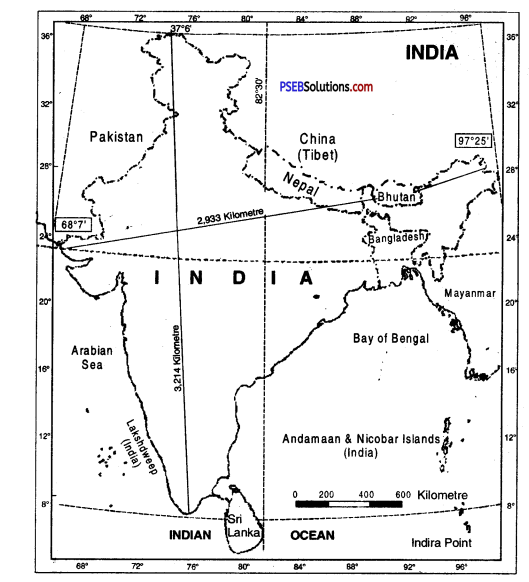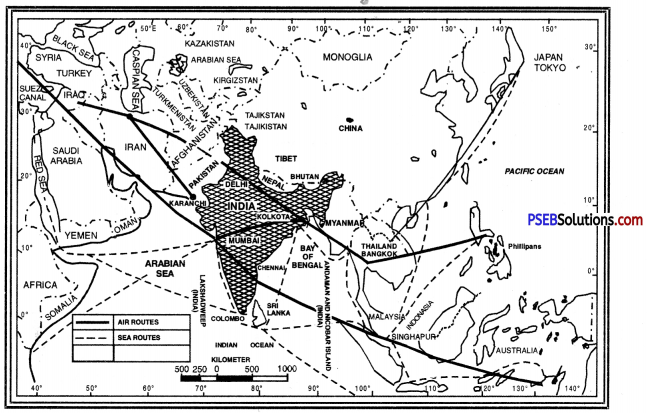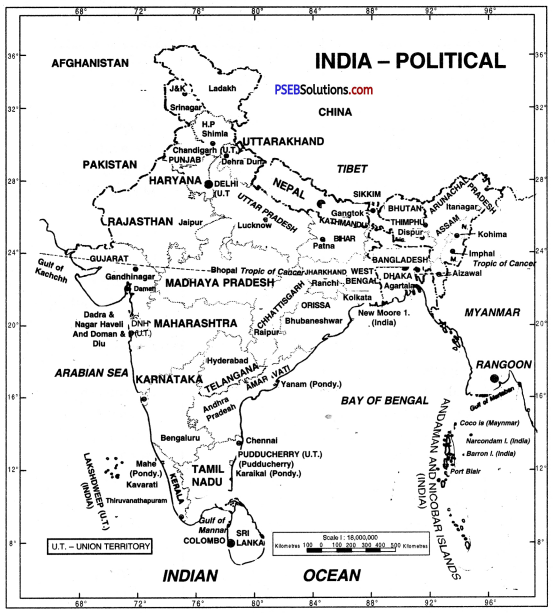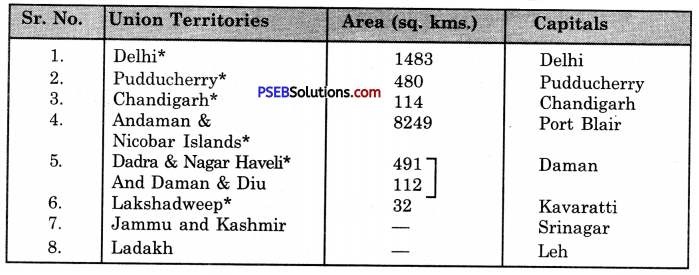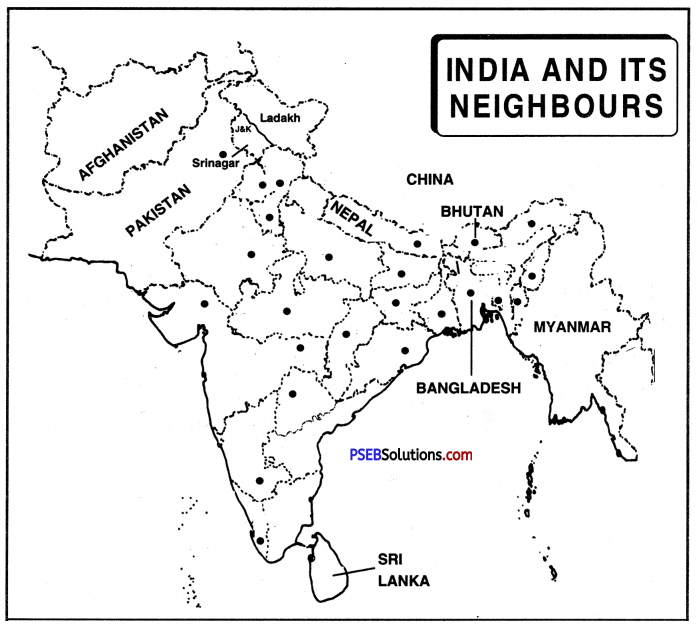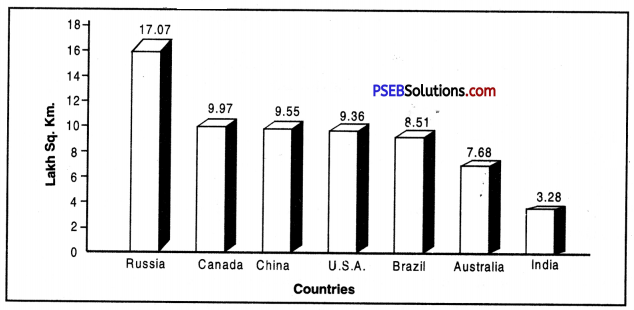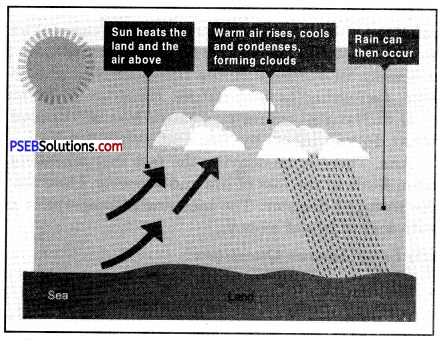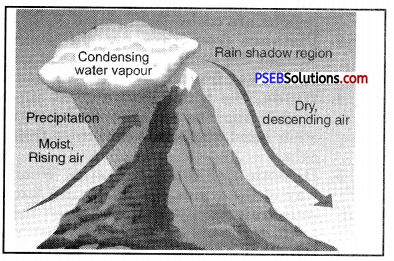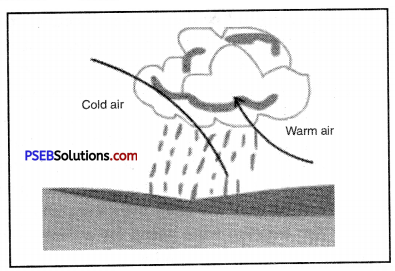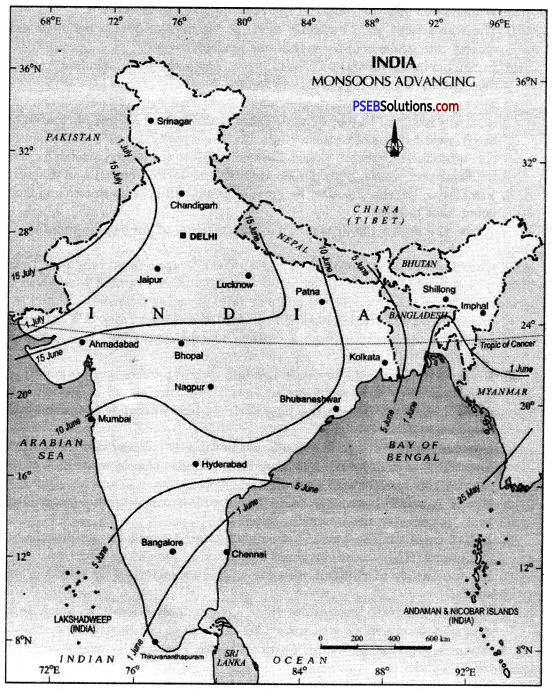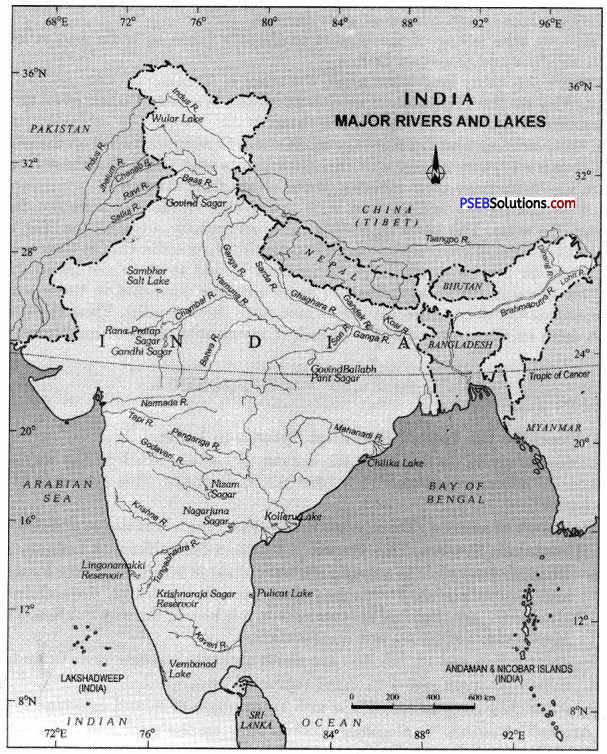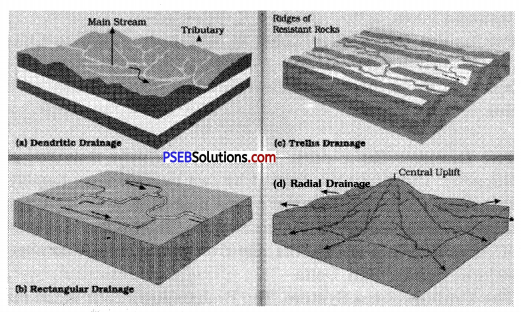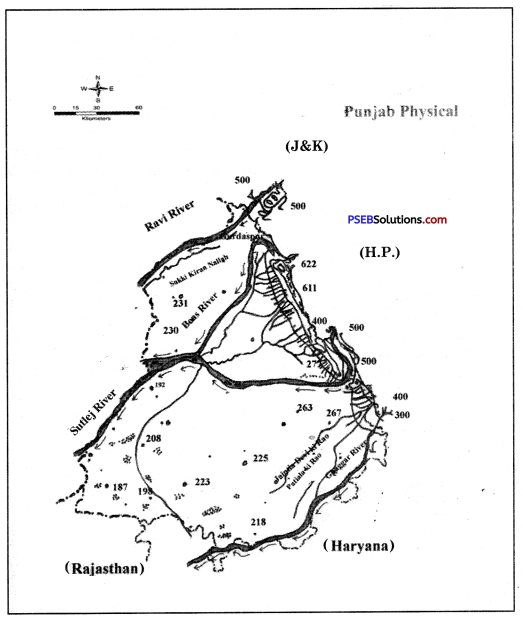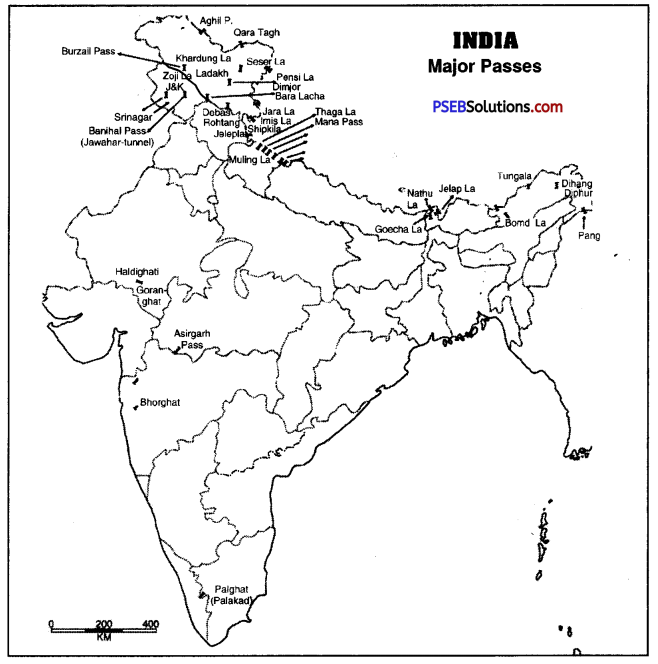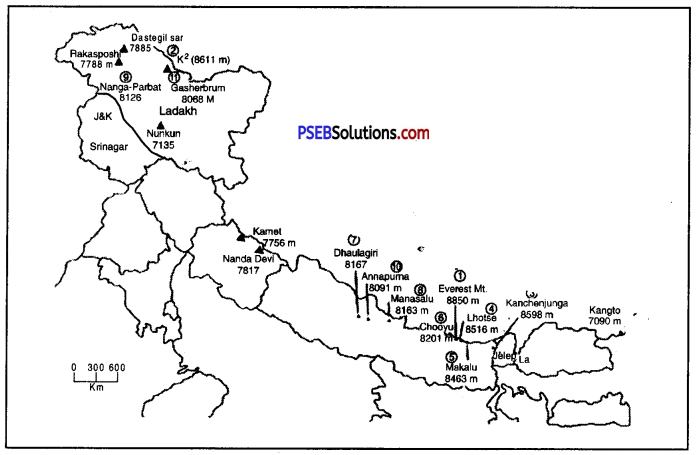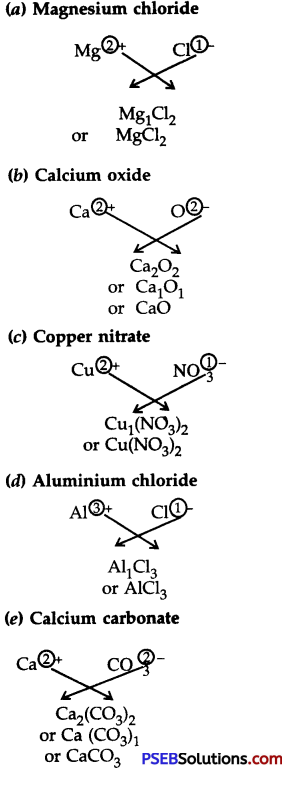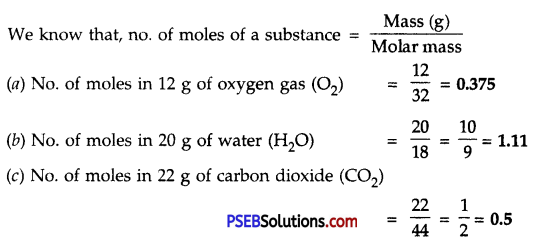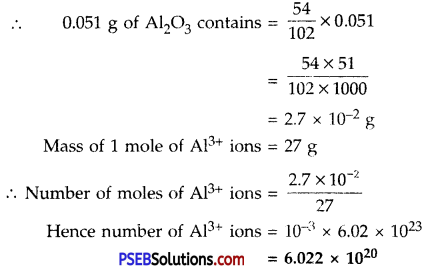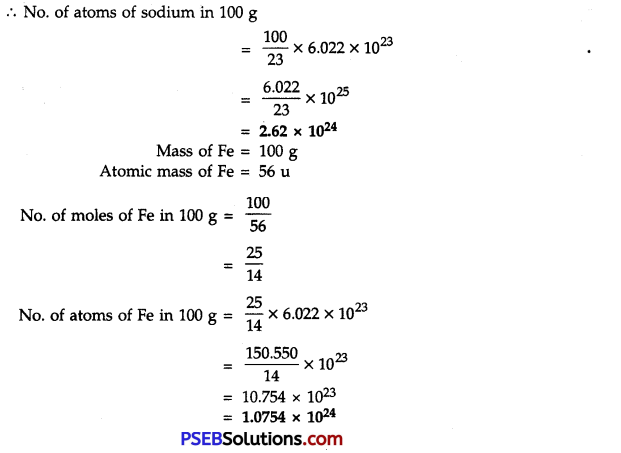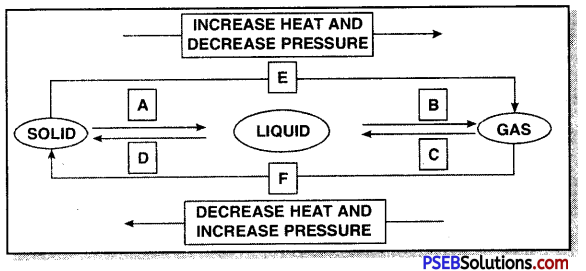Punjab State Board PSEB 9th Class Social Science Book Solutions Geography Chapter 5 Natural Vegetation and Wild Life Textbook Exercise Questions and Answers.
PSEB Solutions for Class 9 Social Science Geography Chapter 5 Natural Vegetation and Wild Life
SST Guide for Class 9 PSEB Natural Vegetation and Wild Life Textbook Questions and Answers
Map Work
Question 1.
Show in the outline map of India:
(i) Any three regions of different types of natural vegetation.
(ii) National parks situated in any five states.
(iii) Water reserves of Punjab (in an outline map of Punjab).
Answer:
Do it yourself with the help of India Map.
Question 2.
Identify the trees shown below and specify the type of vegetation.
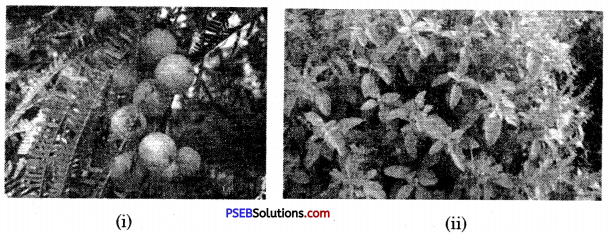
Answer:
Do it yourself.

Question 3.
Make a chart of ten types of trees, five animals and five birds found around you.
Answer:
Do it yourself.
Objective Type Questions :
Answer the following questions in a single word to one sentence length :
Question 1.
Plants prepare their food by way of __________ by receiving __________ from __________
Answer:
photosynthesis, rays, sun
Question 2.
Punjab’s __________ area is under forests which comes to percent of total area.
Answer:
1837 sq. km
Question 3.
Vegetation belongs to __________ sphere and types of __________ makes effect on __________
Answer:
bio, soil, Vegetation.
Question 4.
Which sphere of the Earth has living beings (Human beings)?
(i) Atmosphere
(ii) Lithosphere
(iii) Hydrosphere
(iv) Biosphere.
Answer:
(iv) Biosphere.
Question 5.
Which of the following districts has maximum area under forests?
(i) Mansa
(ii) Roopnagar
(iii) Amritsar
(iv) Bathinda.
Answer:
(ii) Roopnagar.
Question 6.
‘Chinkara’ is type of which animal?
Answer:
Chinkara is a species of gazelle found in Asia.
Question 7.
What is Beerh?
Answer:
In many areas, there exist dense vegetation and its small pieces are known as Beerh.
Question 8.
Name the grass found in semi tropical shrub vegetation.
Answer:
Here a long type of grass-Sarkanda is available.

Question 9.
What percentage of Punjab total area is under forests?
Answer:
6.07%.
Question 10.
Which animals are found in forests with throny vegetation?
Answer:
Camel, lion, rabbit, mice etc.
Short Answer Questions :
Give short answer for the following questions :
Question 1.
Explain Flora and Fauna.
Answer:
Flora. The vegetation or plant kingdom of an area is called flora. It consists of forests, grasslands, flowering and non-flowering trees.
Fauna. The animal kingdom of an area is called fauna. In includes birds, fish, animals, insects, etc.
Question 2.
Why forests be protected? Write a note.
Answer:
- Forests provide many things to meet our requirements like wild fruits, nuts, berries, etc. Many tribes are dependent on gathering of these products in forests.
- Forests are source of timber for house building, furniture making, ship building etc.
- Forests supply about 40% of fuel of the world. Wood has been the major source of fuel in houses, smelting industries and running locomotives.
- Softwood supply raw materials for wood pulp, paper, rayon industries.
- Many products like rubber, pitch, gum, tanning materials cork, camphor, fir, herbs, etc. are gathered from forests.
- Forests provide plywood and fibre wood for packing purposes.
- Forests help in rainfall by capturing moisture in the air. These effect the climate of an area.
Question 3.
Describe Characteristics of evergreen forests.
Answer:
- There is no definite time for trees to shed their leaves and these forests appear green all the year around.
- These forests grow in the areas having more than 200 cm. of rainfall and in hot and humid ragion.
- The trees can reach great heights upto 60 metres or even above.
- Because they are dense forests, they form a canopy at the top and many a times sun rays do not reach the land.
- Dense small vegetation also grows under the trees and it becomes difficult to move from this region.
Question 4.
Introduce with natural vegetation of Punjab.
Answer:
Presently, only 6.07% of the total land of Punjab is under forests. Its major part of the forest is grown by humans. The natural vegetation of Punjab can be divided in many parts such as :
- Himalayan Type Moist Temperate Vegetation.
- Sub Tropical Pine Vegetation.
- Sub Tropical Scrub Hill Vegetation.
- Tropical Dry Deciduous Vegetation.
- Tropical Thorny Vegetation.
Question 5.
How Aawla, Tulsi and Cinchona may be beneficial for human beings? Write.
Answer:
- Aawla (Indian Gooseberry). It is full of Vitamin C and it helps in improving digestive system. It is also used to remove constipation, diabatese and cough.
- Tulsi. If any one is suffering from fever, clold or cough, Tulsi is quite helpful.
- Cinchona. Bark of Cinchona plant is used to make Quinine and is given at the time when one is suffering from Malaria.
Long Answer Questions :
Answer the following questions in detail:
Question 1.
How natural vegetation is lungs of a society?
Answer:
There is no denying the fact that natural vegetation is the lungs of human society and it will become clear with the following points.
- Trees release oxygen and inhale carbon dioxide. This oxygen gives life to humans and animals.
- Forests help in increasing underground water level.
- Water available in forests become water vapour due to sun’s heat which helps in reducing air temperature.
- Many animals live in forests and forests are the permanent habitat for them.
- Forests are quite helpful in making our environment clean and healthy.
- Forests also help in reducing the speed of lands, to reduce noise pollution etc.
- They play an important role in having rainfall.
- Forests also help in stopping soil erosion as trees hold the soil tightly.

Question 2.
Classify Indian forests on basis of climate and name trees of each class.
Answer:
Types of Forests. Due to variation in rainfall, temperature and altitude, there is a great variety of natural vegetation in India. The following different types of forests are found in India :
1. The Tropical Rain Forests. These forests are found in areas where annual rainfall is more than 200 cms and the mean temperature is more than 20°C. These forests are found in western parts of Western Ghats, Plains of West Bengal, Orissa, Eastern Himalayas, and Andaman Islands. These forests grow rapidly due to high temperatures and high rainfall. Sometimes these trees reach a height of 60 metres. These are hard wood trees like equatorial forests. These are evergreen trees because these do not shed their leaves. These forests include the trees like Rubber, Mahogany, Iron wood, rose wood, Gurjan and Bamboos.
2. The Monsoon or Tropical Deciduous Forests. These forests are found in areas where rainfall is between 70 and 200 cms. These trees shed their leaves in hot dry season. So these are called deciduous forests. These forests are found in Terai, Chotta Nagpur plateau (Jharkhand and Chhattisgarh); eastern slopes of Western Ghats and eastern part of peninsular India. These are not dense forests. These forests are the true monsoon forests. These form the natural cover all over India. These are of two types : (0 moist (ii) dry. Teak is the important species of moist deciduous and is found in Chotta Nagpur plateau. Sal is the dry deciduous found over peninsular India.
3. Thorn Forests and Scrubs. These forests occur where annual rainfall is less than 70 cms. These are found in eastern Rajasthan, Saurashtra, Malwa plateau (M.P.), Southern Haryana, S.W. Uttar Pradesh and Karnataka Plateau.’ These trees have long roots, thick bark. These trees are scattered. These gradually merge into scrubs and thorny bushes. These form of typical desert vegetation. These forests include Shisham, Babul, Kikar, Khair and Haldu. These are hard wood trees.
4. The Tidal Forests. These forests are found in deltas of rivers in coastal areas. These are called Tribal forests of Deltaic forests. These forests are found in Ganges—Brahmaputra Delta, Delta of Mahanadi, Godavari, Krishna and Cauvery. These are marshy areas. In West Bengal in Ganga, Brahmaputra delta, these forests are called Sunderbans because Sundari tree is found in this area. These forests include the tree of Sundari, Mangrove, Gurjan and Hintal. These trees are used for boat building, fuel, match boxes and house building.
5. The Mountain Forests. These forests are found on the southern slopes of Himalayas from Kashmir, to Assam. Mixed deciduous and coniferous forests are found. A gradual change in vegetation occurs according to altitude and climate. In western Himalayas, coniferous forests are found due to low rainfall and low temperature. But in eastern Himalayas, evergreen forests are found as there is heavy rainfall and high temperatures.
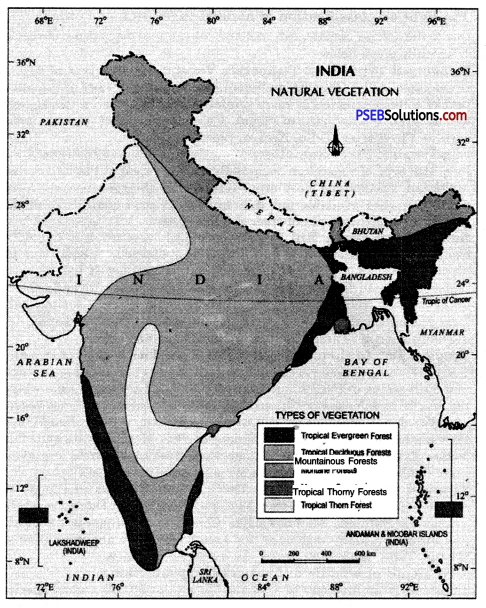
Forests of India
- Tropical moist forests of sal are found upto a height of 1200 metres in foothills.
- Temperate forests of oak, chestnut and pine trees are found upto a height of 2000 metres.
- Coniferous forests are found upto a height of 3800 metres. These include Spruce, Deodar, Pine, Birch, Silver fir, etc.
- Alpine pastures are found beyond 3600 metres where pastoral tribes like Gujjars graze their sheep on short grasses.
Question 3.
Put light on classification of natural vegetation of Punjab.
Answer:
Due to the diverse climate, soil and land, we can find many types of vegetation in Punjab which is given below :
1. Himalayan Type Moist Temperate Vegetation. This type of vegetation is available in the Dhar Kalan Tehsil in Pathankot district of Punjab. This part of Punjab experiences more rainfall and is situated on the higher side as compared to other parts of Punjab. Here many types of trees are available such as Cheel trees, Tahli, Keekar, Shahtoot, Mango.
2. Sub-Tropical Pine Vegetation. Many Tehsils of many Districts of Punjab have this type of vegetation such as Pathankot tehsil of Pathankot district, Mukerian, Dasuha and Hoshiarpur tehsils of Hoshiarpur districts. Very few Cheel trees are available but they are not of good quality. Tahli, Khair, Shahtoot and other types of trees are found here.
3. Sub-Tropical Scrub Hill Vegetation. Such vegetation is found in the eastern parts of Hoshiarpur and Roop Nagar districts. Around four to five decades ago, this region had dense vegetation but now it has been scrubs region also due to deforestation, grazing of animals, forest fire and soil erosion. Many types of trees are found here such as Tahli, Khair, Keekar, Shahtoot, Dek, Neem, Bamboo, Amaltar etc. A long grass, called Sarkanda, is also available over here and it is used to make rope and paper.
4. Tropical Dry Deciduous Vegetation. Dry and hot regions of Punjab have this type of vegetation. It is available in the plains of Kandi region, high-low and open plains of Punjab and Central plains. There was a time when this region also had dense vegetation. Even today few patches of dense vegetation are available in many areas and these are known as Beer, Jhangi or Jhiri. Beer Bhadson, Chat Beer, Beer Bhunarheri, Beer Moti Baag are quite famous. Neem, Tahli, Bobar, Peepal, Mango tree, Keekar etc. trees are available here. Safaida and Popalar plants are also grown over here.
5. Tropical Thorny Vegetation. There are many areas in Punjab” which experience less rainfall and they have such vegetation. Thorny vegetation is available in Bathinda, Mansa, Fazilka, Central and southern parts of Faridkot and Firozepur. Many regions of this area do not have any vegetation at all. Cactus, Tahli, Keekar etc. trees are available over here.

Question 4.
Give detail of wildlife and ways of its protection.
Answer:
India has great diversity of animals. More than 56,000 animal species are there in India. Around 2500 types of fish are there in the fresh and salty water of India. Around 2000 types of birds are also there. Many of the important animal species live in India but there is a situation of worry that many animal and bird species have become extinct. That’s why it is must to protect our wildlife. Humans have created an awkward situation by recklessly cutting forests and trees. Presently very few rhinos, cheeta, monkeys, lions etc. are available. That’s why it is the duty of everyone to protect the wildlife.
Measures of Protection of Wildlife.
1. Fourteen biosphere reserves has been set up in the country, and three out of them are the Sunderbans in the West Bengal, the Gulf of Manner in Tamil Nadu and the Nilgiris (Kerala, Karnataka and Tamil Nadu) are included in the world network of Biosphere reserves.
Main Bio-reserves
- Sunderbans (West Bengal)
- Simiipal (Orissa)
- Gulf of Mannar (Tamil Nadu)
- Dthang-Dibang (Arunachal Pradesh)
- The Nilgiris (Tamil Nadu)
- Dibru-Sailkhowa (Assam)
- Nanda Devi (Uttaranchal)
- Agas Thyamalai (Kerala)
- Nokrek (Meghalya)
- Kanchenjunga (Sikkim)
- Great Nicobar
- Panchmari (Andaman-Nicobar) (Madhya Pradesh)
- Manas (Assam)
- Acharakmar Amarkantak (Madhya Pradesh)
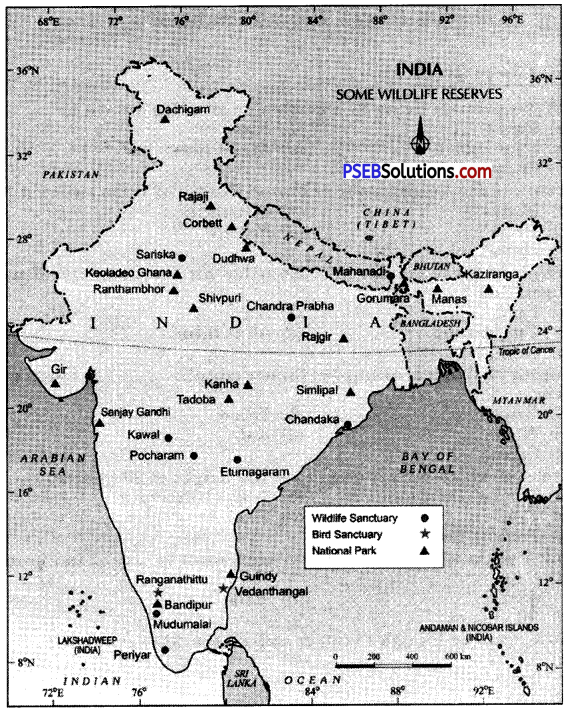
2. Financial and technical assistance is provided to many Botanical gardens by the government since 1992.
3. Project Tiger, Project rhino, Project Great Indian Bustard and many other eco- developmental projects are introduced.
4. Many facilities to develop awareness among the people and to educate people for the benefits of flora and fauna are provided.
5. 89 National Parks, 49 Wildlife sanctuaries and Zoological gardens are set up to take care of Natural heritage.
PSEB 9th Class Social Science Guide Natural Vegetation and Wild Life Important Questions and Answers
Multiple Choice Questions:
Question 1.
All the animals living in a particular area are known as
(a) Fauna
(b) Flora
(c) Hydrosphere
(d) Atmosphere.
Answer:
(a) Fauna.
Question 2.
Where is the headquarter of Forest Survey of India situated?
(a) Mussorie
(b) Dehradoon
(c) Delhi
(d) Nagpur.
Answer:
(b) Dehradoon.

Question 3.
Which of these factors is responsible for the diversity of natural vegetation?
(a) Land
(b) Soil
(c) Temperature
(d) All of these.
Answer:
(d) All of these.
Question 4.
Leaves of Tropical evergreen forests remain __________ through out the year.
(a) Green
(b) Yellow
(c) White
(d) Red.
Answer:
(a) Green.
Question 5.
Trees of which forests can reach the height of 60 m or above?
(a) Tropical Deciduous
(b) Tropical Evergreen
(c) Tidal
(d) Thorny.
Answer:
(b) Tropical Evergreen.
Question 6.
Small parts of dense vegetation are known as __________ in Punjab.
(a) Beer
(b) Jhiri
(c) Jhangi
(d) All of these.
Answer:
(d) All of these.
Question 7.
How much of Punjab’s land is under natural vegetation?
(a) 5.65%
(b) 3.65%
(c). 4.65%
(d) 6.65%.
Answer:
(b) 3.65%.
Question 8.
Which of the following districts of Punjab have maximum vegetation?
(a) Bathinda
(b) Patiala
(c) Roop Nagar
(d) Faridkot.
Answer:
(c) Roop Nagar.
Question 9.
Around people are working with the forest department of Punjab.
(a) 5500
(b) 6500
(c) 7500
(d) 8500.
Answer:
(b) 6500.

Question 10.
Which of these is the largest mammal on earth?
(a) Elephant
(b) Rhino
(c) Hippo
(d) Giraffe.
Answer:
(a) Elephant.
Question 11.
__________ is the national bird of India.
(a) Sparrow
(b) Peacock
(c) Koel
(d) Flamingo.
Answer:
(b) Peacock.
Fill in the blanks:
Question 1.
There are __________ national parks and wildlife sanctuaries in India.
Answer:
103, 544
Question 2.
__________ is full of Vitamin C.
Answer:
Amla
Question 3.
The seeds of __________ are used to control diabetes.
Answer:
Jamun
Question 4.
In Sanskrit Neem is called as __________
Answer:
Neem
Question 5.
Life on earth is possible because of four spheres i.e. biosphere, __________ and atmosphere.
Answer:
Geosphere, hydrosphere

Question 6.
The dependency of humans on four spheres is known as __________
Answer:
Ecosystem.
Very Short Answer Type Questions
Question 1.
Name the four spheres of Earth.
Answer:
Lithosphere, atmosphere, hydrosphere and biosphere.
Question 2.
What is Biosphere?
Answer:
Biosphere is that sphere of the earth in which many types of animal species live.
Question 3.
What do you mean by Fauna?
Answer:
All the animals living in a particular area and time are called Fauna.
Question 4.
What is Flora?
Answer:
All the vegetation available in an area is called Flora.
Question 5.
How is ecosystem formed?
Answer:
The interdependence of plants and animals in an area forms the ecosystem.
Question 6.
What is Natural Vegetation?
Answer:
That vegetation which grow without any human effort is called natural vegetation.

Question 7.
On which factors do natural vegetation depends?
Answer:
Natural vegetation depends upon land, soil, temperature, duration of sunlight, rainfall etc.
Question 8.
Which trees are grown in high mountains?
Answer:
Cheel or Spurse are the trees grown in high mountains.
Question 9.
In which soil, the dense forest is grown?
Answer:
In delta soil.
Question 10.
What is Photosynthesis?
Answer:
The process of preparing food by plants through sunlight is called photosynthesis.
Question 11.
In how many parts can we divide Indian vegetation?
Answer:
Indian vegetation can be divided in five parts.
Question 12.
Give one feature of Tropical Evergreen forests.
Answer:
Tress do not shed their leaves collectively and that’s why they remain green through out the year.
Question 13.
In which areas can we find Tropical Evergreen forests?
Answer:
In those areas which are hot and humid and which experience more than 200 cm annual rainfall.
Question 14.
Which forests are called rain forest?
Answer:
Tropical Evergreen forest.

Question 15.
Which trees are found in Tropical Evergreen forest?
Answer:
Mahagony, Rosewood, Ebony, Rubber, Cinchona, Bamboo etc.
Question 16.
What is the use of bark of Cinchona tree?
Answer:
It is used to make quinine medicine which is quite helfpul for the patients of Malaria.
Question 17.
In which area Tropical Evergreen Forests are available?
Answer:
Slopes of eastern and western Ghats, Hills of north-west India, Tamil Nadu coast, few parts of West Bengal, Odisha, Andaman Nicobar islands and Lakshdweep islands.
Question 18.
Where can we find Tropical Deciduous forests?
Answer:
In those areas which receive 70-200 cm of annual rainfall.
Question 19.
Give one feature of Tropical Deciduous forests?
Answer:
They shed their trees according to the season.

Question 20.
Name the types of Tropical Deciduous forest’s?
Answer:
Wet Tropical Deciduous forests and Dry Tropical Deciduous Forests.
Question 21.
In which areas can we find wet Tropical Deciduous forests.
Answer:
In those regions which experience 100-200 cm of annual rainfall.
Question 22.
In which parts of India can we find Wet Deciduous forests?
Answer:
North Eastern States, Western Ghats, Odisha, few parts of Chhattisgarh.
Question 23.
Which trees are available in wet deciduous forests?
Answer:
Saal, Teek, Deodar, Neem, Sal etc.
Question 24.
In which areas can we find Scrubs and Thorny forests?
Answer:
In those areas which experience less than 70 cm. of annual rainfall.
Question 25.
Which trees are there in dry deciduous forests?
Answer:
Peepal, Teek, Neem, Saal etc.

Question 26.
In which states can we find Scrubs and Thorny forests?
Answer:
Rajasthan, Punjab, Haryana, Gujarat, Uttar Pradesh etc.
Question 27.
Delta of which rivers can have tidal forests?
Answer:
Ganga, Brahmaputra, Mahanadi, Godavari, Krishna and Kaveri.
Question 28.
What is Sundervan?
Answer:
The forests available in the delta region of Ganga and Brahmaputra is called Sundervan because Sundari trees are found here.
Question 29.
Which trees are found in Mountainous forests?
Answer:
Cheel, Spruce, Deer, Oak, Fur etc.
Question 30.
Which animals are found in Mountainous forests?
Answer:
Deer, Yak, Snow Leopard, Beer, Wild sheep, Wild goat etc.
Question 31.
Which soils are found in Punjab?
Answer:
Alluvial soil, Sandy soil, Clayey soil, Loamy soil, Hill soil or Kandi soil, Sodic and Saline soil.

Question 32.
What did the British do to save natural vegetation?
Answer:
They classified the forests and stopped the animals to graze there.
Question 33.
Which vegetations are found in Punjab?
Answer:
Himalayan Type Moist Temperature vegetation, Sub Tropical Pine vegetation, Sub Tropical Scrub Hill Vegetation, Tropical Dry, Deciduous Vegetation and Tropical Thorny vegetation.
Question 34.
What is Beer?
Answer:
There exist few small pieces of dense vegetation in plains which are called Beer.
Question 35.
How much of Punjab’s total land is under natural vegetation?
Answer:
Only 3.65%
Question 36.
Which district of Punjab is under maximum natural vegetation?
Answer:
Roop Nagar district-37.19%.
Question 37.
Give one importance of Forests?
Answer:
Trees inhale carbon dioxide and release oxygen which is quite important for humans.
Question 38.
What is Wildlife?
Answer:
Animals, birds, reptiles living in the natural habitat or forests are called wildlife.
Question 39.
How many species of animals live in India?
Answer:
There are around 89,000 species of animals living in India which becomes 6.5% of the worlds animal species.
Question 40.
Name few animals found in Indian forests.
Answer:
Elephant, Rhino, Deer, Barasingha, Lion, Monkey, Langoor, Crocodile, Tortoise etc.
Question 41.
Which animal is called the Bull of Snow?
Answer:
Yak.
Question 42.
Which animal gives us Kasturi?
Answer:
Musk deer.
Question 43.
How many species of birds live in India?
Answer:
Around 2000 birds.

Question 44.
Name few birds which migrate to India during winters.
Answer:
Siberian crane, Amur Falcon, Greater Flamingo, Bluethroat, Bluetailed bee- eater, Bar-headed goose etc.
Question 45.
When and why was Indian Board for wildlife set up?
Answer:
In 1952 to make people conscious about the protection of wildlife.
Question 46.
Why is Bill used?
Answer:
To cure constipation and diarrhoea.
Question 47.
Why is Sarpgandha used?
Answer:
To improve blood circulation.
Short Answer Type Questions
Question 1.
Write a note on Biosphere?
Answer:
There are four spheres on earth and biosphere is the sphere in which many types of species live. This is a complex area in which all other three spheres meet. As life exists in this sphere that’s why it is quite important in our life. These species include from bacteria till elephant. All the species can be divided in two parts Flora and Fauna. All the plants come under Flora and all the animals are included in Fauna.
Question 2.
Why is natural vegetation different in different areas?
Answer:
Natural vegetation is different in different areas because it is affected by different geographical factors. The geographical factors any area have, same type of vegetation will grow over there. Natural vegetation is affected by many factors such as :
- Land
- Soil
- Temperature
- Rainfall
- Duration of Sunlight.
Question 3.
Give features of Tropical Evergreen forests.
Answer:
- Tropic evergreen forests grow in such areas which experience more than 200 cm. of rainfall.
- All the trees do not shed their leaves at same time and that’s why they remain green through out the year.
- Such forests are found in hot and humid regions.
- Its trees reach the height of more than 60 metres and due to their denseness, they form a canopy at the top. This is the reason that at many places, sunlight is unable to reach the land.
- Mahagoni, Rosewood, Ebony, Bamboo, Cinchona, Rubber etc are the trees formed here.
- Such forests are there in many parts of India such as slopes of western side of Western Ghats, North-Eastern hills, few parts of Odisha and West Bengal, Lakshdweep and Andaman-Nicobar islands.

Question 4.
Give few features of Tropical Deciduous forests.
Answer:
- Tropical Deciduous forests grow in the areas which experience the rainfall of 70-200 cm. annually.
- Trees shed their leaves according to season which is from 6-8 weeks during summer.
- Such forests are of two type-Wet deciduous forests (100-200 cm rainfall) and dry decidiuous forests (70-100 cm rainfall).
- Many trees are found here such as Teak Sandal wood, Saal, Deodar, Khair, Peepal, Neem, etc.
- Such forests are not dense like evergreen forests but are dense enough.
Question 5.
Name the soils found in Punjab.
Answer:
Different areas of Punjab have different types of soil and these are :
- Alluvial Soil
- Sandy Soil
- Clayey Soil
- Loamy Soil
- Hill Soil or Kandi Soil
- Sodic and Saline Soil.
Question 6.
What efforts were made by the British to protect natural vegetation?
Answer:
Punjab’s vegetation region was continuely decreasing due to many factors such as reckless cutting of trees, animal grazing and lack of laws. That’s why the British took certain steps to save natural vegetation and these were :
- Reclamation of forests was made and they were divided into many categories.
- Animal grazing was stopped to save natural vegetation.
- Extra vegetation was cleared to provide land for agriculture. Here more food grains were produced to meet the increasing needs of the people.
Question 7.
Write a note on Wildlife of India.
Answer:
All such wild animal, birds and reptiles which live in their natural habitat i. e. forests are known as wildlife. India experiences many climatic conditions and have many types of soil and that’s why it has many natural habitats. This is the reason it has variety of wildlife. More than 89,000 species of animals live in India which is 6.5% of the total animal species of the world. In the same way India has 2000 species of birds, 2546 species of fish, 458 types of reptiles.

Question 8.
Which migrated birds come to India during winter season?
Answer:
During winter season many migrated birds come to India and these are :
- Siberian Crane.
- Amur facon
- Greater Flamingo
- Demoiselle Crane
- Black Winged Stilt
- Long Billed Pippit
- Rozy Palicon
- Ruff
- Common Teal
- Gadwall.
Question 9.
Name the migrated birds which come to India during summer season.
Answer:
Many migrated birds come to India during summer season and these are :
- Blue Cheeked Bee Eater
- Asian Koel
- Black-crowned Night Heron
- Eurasian Golden Oriole
- Comb Duck
- Cuckoos
- Blue Tailed Bee Eater.
Question 10.
Discuss the government’s efforts to save wildlife.
Answer:
- Indian Board for wildlife was made in 1952 whose major function is to give advice govt, for wildlife protection to encourage the people for wildlife protection and to create new wildlife habitats.
- In 1972, wildlife protection Act was made to protect the animals which are on the verge of becoming extinct.
- Many Biosphere Reserves were made to protect the diversity of wildlife. Till now 18 Biosphere Reserves have been made.
- To protect and care wildlife in the country, 103 national parks and 544 wildlife sanctuaries have been made where poaching is delcared illegal.
Question 11.
What are the main reasons for our natural vegetation not remaining actually natural?
Answer:
Most of present vegetal cover in India is not really natural. A considerable part of the original cover has been destroyed or changed due to human settlement and use of the land. Much of vegetation is low in quality and content. The original natural vegetation survives only in inaccessible areas of the Himalayas and Thar Desert. In other parts of the country, the vegetation is not ‘natural’ in the real sense of the term.
Question 12.
Analyse the Forest Areas in our country at the regional and state levels.
Answer:
There should be atleast 33% land under forests to keep the ecological balance and for forest development of the country. But in India this percentage is just 22.7.
At state level distribution is unequal as it is clear from the following :
- Tripura (59.6%), H.P. (48.1%), Arunachal Pradesh (48.8%), M.P. (32.9%), Assam (29.3%).
- Punjab (2.3%), Rajasthan (3.6%), Gujarat (8.8%), Haryana (12.1%), W. Bengal (12.5%), U.P. (13.4%).
- The Union Territory of Andaman & Nicobar has the maximum area under forests (94.6%) and National Capital Delhi has minimum (2.1%) area under forests.

Question 13.
Write a short note on Deciduous or Monsoonal Vegetation.
Answer:
The vegetation that shed its leaves in order to have excessive evaporation, before the start of the hot season is called Deciduous or Monsoon vegetation. According to rainfall, the vegetation can be subdivided into two such types :
- Moist Deciduous Forests. This type of vegetation is found where the annual rainfall is 100 to 200 cms. The vegetation is not much dense and the trees can achieve the height of 30 m. Teak, sandal are the main trees.
- Dry Deciduous Forests. This type of vegetation is found in areas having rainfall between 50 to 100 cms. Its long belt starts from Punjab and goes up to Deccan plateau. Kikar, Jand are its main trees.
Question 14.
What type of vegetation is found in Eastern Himalayan region?
Answer:
In Eastern Himalaya, we find 4000 species of flowers and 250 species of ferns. Height, Temperature and Rainfall has great impact on the type of vegetation :
- Upto an altitude of 1200 metres, we can find deciduous vegetation and mixed forests.
- Upto the altitude from 1200 to 2000 metres we find desert evergreen forests. Sal and Magnolia are the main trees.
- Due to decrease in temperature at a height of 2000 to 2500 metres are found temperate type of vegetation. Oak, Chestnut, Laurel, Birch, Maple, alder are the main trees.
- At an altitude between 2500 to 3500 metres, we find coniferrous trees. It includes Silver Fir, Pine, Spruce, Deodar, Rendoderan, Blue pine as main trees.
After some more height short natural grass (Alpine grass) and different types of flowers can be seen.
Question 15.
What have been the implications of indiscriminate cutting of forests in the country?
Answer:
Natural vegetation plays an important role in our life. There has been great deforestation during the last four years which can result in following disadvantages :
- Deforestation has great impact on ecological balance.
- It can create problem of soil erosion due to floods on mountain slopes as well as on plains.
- The northern parts of Punjab are facing the problems of soil erosion.
Question 16.
Which factors are responsible for soil erosion?
Answer:
Soil erosion occur due to mainly two factors-Physical activities and human activities. Presently the process of soil erosion is continuely increasing due to human activities. Physical activities include running water, cyclones, too much rainfall, slope of mountains etc. But human factors are mainly responsible for soil erosion such as deforestation, animal grazing, wrong methods of a agriculture, mining etc.
Question 17.
Write a detailed note on conservation of Wildlife. Suggest three measures to conserve wildlife and explain them.
Answer:
India is rich in fauna and flora. There is a great biological diversity in India. There are about 89,000 known species of animals. It has 2500 species of fish and 1200 species of birds. But many of these fauna have been destroyed by man. Many rare species have become extinct in India. Our rich wildlife is rich heritage formed through centuries. It must be preserved. Many of the fauna are found only in India such as swamp deer, the one horned rhinoceros, the bison. Kashmir stag, Nilgul etc. These rare species are in danger of extinction. Wildlife is a gift of nature and a thing of beauty. Wildlife Act provides for the protection and conservation of these species. For this zoos, national park, bio-reserves, tiger reserves have been established in India.
Long Answer Type Questions
Question 1.
“There is found a sequence of vegetation from Tropical evergreen to Alpine vegetation in India”. Explain this statement.
Answer:
Different types of vegetation region are found in the Himalayas from its southern foothills to high altitudes. The natural vegetation ranges from the equatorial to Tundra Type. A series of vegetation regions exist according to the changes of temperatures and rainfall with altitude.
A gradual change in vegetation results according to altitude and climate.
- Tropical Wet Deciduous Forests. These forests are found along the Southern foot-hills of the Himalayas, upto a height of 1000 metres. Due to high rainfall, dense forests of Sal are found.
- Temperate Forests. The dense wet temperate forests occur upto a height of 2000 metres. These include evergreen Oaks, Chestnut and Pine trees which are commercially useful.
- Broad Leaved Evergreen Forests. These occur between height of 2000 metres and 3000 metres. These include Oak, Laurels and Chestnut trees.
- Coniferous Forests. These occur upto a height of 3500 metres. These include the trees of Pine, Cedars, Silver fir and Spruce. Deodar is commercially important for timber and railway sleepers. At higher altitudes, near the Snow line, Birch, Juniper and Silverfir trees are found.
- Alpine Pastures. These occur beyond a height of 3500 metres. These include short grasses, these are used for transhumane grazing by Nomadic tribes like the Gujjars.

Question 2.
Describe the benefits of natural vegetation to the country.
Answer:
Importance of Forests :
Forests are a valuable resource; like a river system, it is a multiple resource. Forests provide mankind with a number of products. Forests have greatly influenced human activities. Modern civilisation depends more and more on forests.
Following are the direct and indirect advantages of forests :
- Forests provide many things to meet our food requirements like wild fruits, nuts, berries, etc. Many tribes are dependent on gathering of these products in forests.
- Forests are a source of timber for house building, furniture making, ship building, etc.
- Forests supply about 40% of fuel of the world. Wood has been the major source of fuel in houses, smelting industries and running locomotives.
- Soft woods supply raw materials for wood pulp, paper, rayon industries.
- Many products like rubber, pitch, gum, tanning materials, cork, camphor, fir, herbs, etc. are gathered from forests.
- Forests provide plywood and fibre wood for packing purposes.
- Forests help in rainfall by capturing moisture in the air. These affect the climate of an area.
- Forests prevent soil erosion and floods.
- Forests increase the fertility of soil, help agriculture and maintain ecological balance.
- Forests provide shelter to wild animals and help recreation, wild life and hunting.
- They check the advance of deserts.
Question 3.
Discuss the various types and characteristics of soil found in India.
Answer:
India is primarily an agricultural country. The soils of India are classified on the basis of bed rocks and climate conditions.
1. Black Soils. Black soils are mainly found over the Deccan Lava tract including Maharashtra, Madhya Pradesh, Gujarat and Andhra Pradesh. These soils have been formed due to weathering of Lava rocks. These soils cover an area of about 5 lakh sq. km. These soils are rich in lime, iron, magnesia and alumina. These are also called ‘Regur Soils’. These soils are most suitable for cotton cultivation and are known as ‘Black Cotton Soils’.
2. Red Soils. These soils are found in Tamil Nadu, Karnataka, Andhra Pradesh and areas on periphery of Deccan Plateau. These soils have been formed due to decomposition underlying igneous rocks.
3. Laterite Soils. Laterite soils are found on the highland areas of the plateau. These are found in Karnataka, Kerala, Tamil Nadu and hilly regions of Assam, Rajmahal hills and Chota Nagpur plateau. Due to monsoonal climate (wet and dry seasons alternately occurring), there is the leaching of soils.
4. Alluvial Soils. These soils have been deposited by the rivers in river valleys of Mahanadi, Godavari, Krishna and their deltas. These are deep and fertile soils. These are dark soils.
5. Desert Soils. These soils cover 2 lakh sq. km. from dry areas of Rajasthan, Gujarat, Punjab and Haryana. These sandy soils are suited to the cultivation of jowar, bajra, cotton, wheat, etc.
Question 4.
Describe the medicinal plants found in India.
Answer:
Medicinal plants. India is known for its herbs and spices from ancient times. Some 2,000 plants have been described in Ayurveda and atleast 500 are in regular use. The World Conservation Union’s Red list has named for 352 medicinal plants of which 52 are critically threatened and 49 endangered.
- The Rauvolfia Serpentina (Sarpagandha). Used to treat blood pressure; it is found only in India.
- Jamun. The juice from unripe fruit is used to prepare vinegar which is carminative and diuretic, and has digestive properties. The powder of the seed is a cure of diabetes, the bark is good for cough, asthma and dysentery.
- Arjun. The fresh juice of leaves is a cure for earache. It is also used to curve blood pressure problems and heart diseases.
- Babool. Leaves are used as a tonic and a cure for eyesores. It is used as a tonic and medicine for cough, its bark dust is a cure for dog bite.
- Neem. Neem has high antibiotic and antibacterial effects.
- Tulsi Plant is used to cure cough and cold.
- Kachnar is used to cure asthma and ulcers. The buds and roots are good for digestive problems. The root is used as cure for snake bites.
![]()
![]()
![]()



